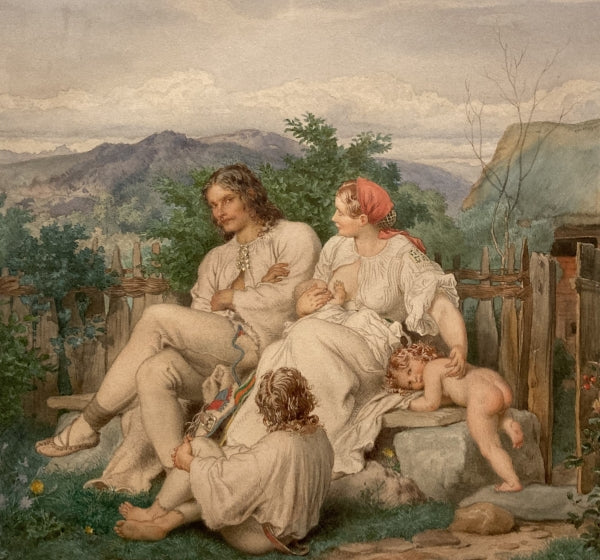Valdštejnská jazdiareň has already become a regular venue for large monothematic exhibitions of prominent Czech artists. After authors such as František Kupka, Toyen and Alfons Mucha, the National Gallery in Prague presents Josef Mánes, one of the top representatives of Czech romanticism of the 19th century. The curators Markéta Dlábková and Veronika Hulíková assembled his collective work into clear logical blocks, both according to the artistic styles that had an influence on his work, and according to the topics that he primarily focused on.
Josef Mánes was born on May 12, 1820 into a Prague artistic family. His father Antonín Mánes was an important landscape painter and at the same time a professor at the Prague Academy of Painting. His uncle Václav Mánes was even a temporary director at this school, and both of his siblings, brother Quido and sister Amália, were painters. At the beginning of his work, Josef Mánes was mainly influenced by Biedermeier, an artistic style typical of German-speaking countries in the 19th century. He was characterized by his moderation, his orientation towards family well-being and his efforts not to deviate to any extremes. In Mánes' work, we meet him mainly in his portrait work, in which he often depicted individual family members or his closest friends. But Mánes was above all an inventive author, so it is not surprising that the austere Biedermayer style of painting did not suit him for a long time and he soon switched to romanticism, which in the Czech lands was mainly based on the depiction of national history and ethnography. In Mánes's work, we can see the features of romanticism in his landscape work, which often depicts extreme natural phenomena, which is how he followed up on his father. For example, in paintings from around Řipsko and Mělník, such as the Elbe landscape, where he captures the unrestrained landscape of the confluence of the Elbe and Vltava rivers, or Hrobár, in which, under the influence of his illness, he reflects on the theme of the end of life and taking stock of its meaning. But also in returning to mythological themes such as The Last Moments of Luke of Leyden, The Meeting of Petrarch with Laura in Avignon or Oldrich and Bozen. However, Mánes was also fascinated by folklore, especially Moravian folklore, which he probably came closest to during his stay at the castle in Čechá pod Kosířem. He visited the Hanej region in 1854 at the invitation of his friend Count Bedřich Silva-Tarrouc and created a number of portraits of costumed figures here, as well as some of his best works such as The Lullaby or Life on the Manor. During his study trips, he also visited Slovakia, where he was captivated by the local folk culture. The painter was convinced that the Slovak costume is the closest to the delicate Slavic purity, which he captured, for example, in the watercolor Slovak family. But even the characters on the Calendar Board at the Prague Astronomical Clock are dressed in Slovak costumes, which the city hall officials did not like at the time of its creation. Josef Mánes was generally not in the favor of the authorities at the time, because he was too innovative for his time and he only got this contract thanks to the fact that the architect František Václavík interceded on his behalf. Moreover, there was not too much interest from the artists in the work on the Calendar Board, because the town hall offered a paltry fee of 500 guilders for its implementation, which did not even cover the costs of buying paints. Mánes, however, despite great distrust from the city, finally finished the board after two years of work. Unfortunately, due to the outbreak of the Austro-Prussian war, its ceremonial unveiling took place only later and without the presence of the author himself. Due to his bohemian lifestyle, the painter was in constant financial problems. Basically, he lived only from portrait work for wealthy middle-class families or from the occasional sale of nudes, which reminds us of the oils Morning and Evening, where the central theme is an exposed young woman. He allegedly created these works as repayment of a debt to a usurer and therefore did not even sign them with his own name, but only with the signature LG 1857. Their importance lies mainly in the fact that these are the first modern works in Czech art of the 19th century. Josef Mánes' wide-ranging scope is also evidenced by the fact that, in addition to painting, drawing and graphics, he also devoted himself to ornamental work and illustrations, including fairy-tale ones. He drew ornamental motifs from the Romanesque, Gothic styles and from the folk environment. The combination of the Romanesque base with Renaissance motifs influenced by folk decorations became a significant feature of the so-called "Manes style". He applied it mainly in the Royal Court Manuscript, but also in designs for title pages, diplomas or federal flags. The fairy tale motif also appears in his later painting Drowned from 1867, which was created under the influence of progressive mental illness. The scene with the water fairies luring him under the surface can be understood as an expression of his deepening mental suffering. Josef Mánes probably died of progressive paralysis in 1871 at the age of only 51. However, his legacy will become an inspiration for many young artists posthumously, especially from the so-called National Theater generation, such as the sculptor Josef Václav Myslbek or the painter Mikoláš Aleš, whose works still pay tribute to Mánes's genius in the Valdštejnská jazdiarni. Text and photo: Vladimír Dubeň







